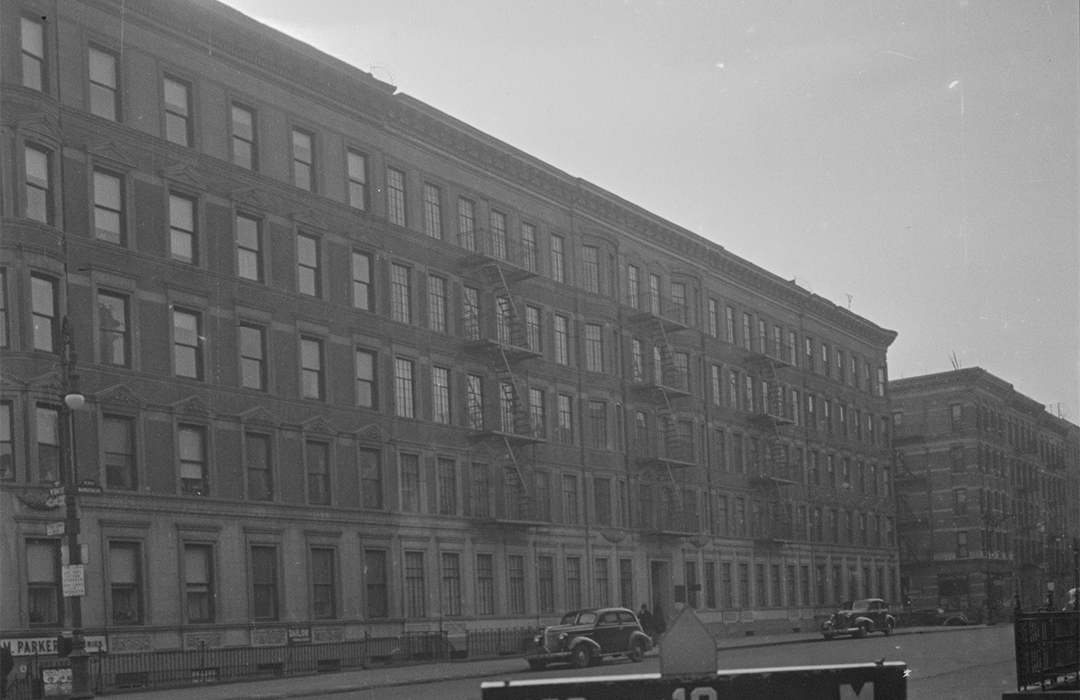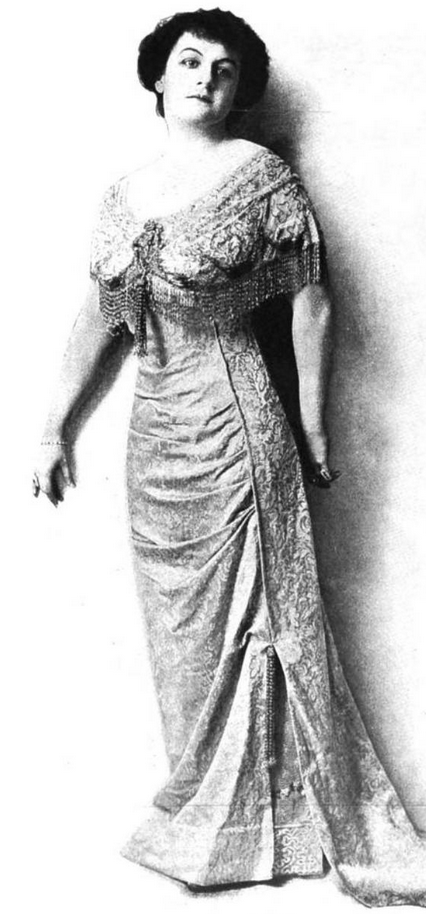
78 Manhattan Ave.
by Tom Miller
In 1895 real estate developer Robert Dick hired architect Martin V. B. Ferdon to design three five-story-and-basement apartment buildings that would engulf the eastern block of Manhattan Avenue between 103rd and 104th Streets. The end buildings opened onto the side streets, while 78 Manhattan Avenue nearly filled the avenue blockfront.
Sitting upon a limestone base and fronted by a light moat, the upper floors were faced in gray brick and trimmed in limestone. Ferdon’s reserved Renaissance Revival design included classical pediments and occasional carved panels. The flat, vertical plane of the large structure was relieved by two slightly bowed sections above either side of the entrance.
Among the original tenants was the family of Ernest Ordemann, “a rich saloon keeper on Sixth Avenue,” according to The New York Times. Living with the Ordemanns were their daughter, Sophia, and her new husband, Henry Glover Hemming. Hemming had divorced his wife, the former Louise Genin, in January 1897, and she received full custody of their three-year-old son. Although the divorce decree prohibited him from ever marrying while Lousie was alive, the New York Herald said, “About the time the divorce was granted, he began paying attentions to Miss Sophie Fredericks Ordemann.” They were married two months after the divorce was finalized.
Louise had been an actress before marrying (at the age of 16). Now, “a pretty little actress about twenty years of age,” as described by the New York Herald, she returned to the stage. She joined De Wolf Hopper’s El Capitan company on a nationwide tour and gave Henry temporary custody of John. A significant problem arose when Louise returned to New York. In the meantime, Ernest Ordemann had become very fond of his new step-grandson. The New York Herald remarked that he, “recently presented him with a pony and cart.” Louise demanded her son back, and Ernest Ordemann, “is opposed to allowing Mrs. Hemming to take him from his home,” reported The New York Times.
Louise insisted that she would be able to support the boy, saying she “is soon to be married to a rich lumber merchant.” She refused to divulge his name, however. Although Hemming had violated the terms of the divorce by remarrying, the thought of an actress rearing an impressionable child was something to consider. In court on August 3, Justice Pryor said, “I will not give the child’s mother its custody unless I consider her a fit person.” He deferred a decision.
The divorce decree prohibited him from ever marrying while Lousie was alive…
In an interesting side note, Henry Glover Hemming would marry two more times. His third wife, actress Edgena De Lespine, died on January 30, 1920. He quickly married her sister, Helen. Six days after their marriage, Hemming was shot dead at their country home. The body of Frank Eberhardt, a gardener, was found in his room shortly afterward. The assumption was that Eberhardt murdered Hemming and killed himself, but suspicion surrounded Helen for the rest of her life.
- B. Mook and his wife were also original tenants. Mook was a co-founder of the Terrace City Motor Car Company. He was, as well, a tenor in the choir of South Fifth Avenue Reformed Dutch Church on Fifth Avenue and 21st Street, and of the Excelsior Masonic Lodge choir. The couple suffered a frightening incident on December 2, 1897.
At about 11:00 that morning, Mrs. Mook left home to go shopping downtown. The next day, the New York Journal and Advertiser reported, “A man excited and evidently greatly afflicted rushed into the West One Hundredth street station yesterday and begged the aid of the police to help him find his wife who went shopping and had not returned.”
Mook had come home to an empty apartment. He gave the police an astonishingly detailed description. “Five feet tall, thirty-nine years old, wearing a black silk skirt, cloth jacket, buttoned boots and diamond earrings.” While the police sent out a general alarm, Mook “went out to make the rounds of his friends’ houses,” said the article.
In the meantime, at 5:30 Policeman Hayes of the Leonard Street station had discovered “a young woman suffering from hysteria in the waiting room of the Desbrosses street station,” said the New York Journal and Advertiser. “She was unconscious, and he sent her in an ambulance to Hudson Street Hospital.” (How Officer Hayes could diagnose an unconscious woman with hysteria is unclear.) Not long after Mook’s report, the sergeant at the Leonard Street station received the general alarm. He recognized the detailed description as the same as the woman taken to the hospital. The New York Times reported, “Mr. Mook at once proceeded to the hospital and there learned that his wife was resting easily.” The article explained that she had been “taken suddenly sick.”
The Hall family lived here at the turn of the century. Harry Young Hall was a member of the New York Southern Society. The couple’s son, Harry, Jr., who was an electrical operator with the Manhattan Railway Co., became a member of the American Institute of Electrical Engineers in March 1903.
Living here at the time were Fred H. Rindge, his wife, Bertha W., and their son Fred Jr. The year that Harry Hall, Jr. was accepted into the AIEE, Fred, Jr. was a junior at De Witt Clinton High School. Five years later, he was entering his first year of graduate work at Columbia University. He had been an “all-around gymnastic champion” his first year, and graduated as class valedictorian, served on the commencement committee, and won the Alumni Prize.
In 1906, the Trimper family’s apartment was in the rear, facing the light court. It was close enough to the corner building on 104th Street, that Mary E. Marsh, whose apartment in that building was on the same floor, could see into that of the Trimpers’. The Trimper family and Mary Marsh had been very close. As a matter of fact, according to Mary Marsh, the Trimpers formerly lived in her apartment, “but moved into the adjoining building recently.” The separation was, apparently, not amicable.
May Trimper had worked in a publishing firm until June 1906, when she quit in anticipation of her upcoming marriage to Dr. Walter Sedgwick. On August 7, May went to the West Side police court and, according to The Sun, complained that Mary Marsh “had threatened to go to Miss Trimper’s fiancé…and tell him stories about the young woman.” And, while she was venting her accusations, May added that she “wanted to know why Mrs. Marsh tossed newspapers into the Trimper window and said mean things across the airshaft.” On the morning of the hearing, Mrs. Marsh asserted, “she hadn’t tried to interfere with Miss Trimper’s wedding in any way.”
The Great Depression caused some citizens to run afoul of the law.
An interesting tenant was illustrator Robert J. Wildhack, who lived here as early as 1916. Born in the Midwest, he moved to New York in 1901 and studied at the Chase School of Art under Robert Henri. Among his classmates were Rockwell Kent, Edward Hopper, and Coles Phillips. He started making drawings for automobile advertisements and, in 1906, did a series of drawings of automobiles and parts for Motor Magazine.
In 1910, Wildhack joined the Society of Illustrators. In 1917, while still living here, he was brought into the Division of Pictorial Publicity by Charles Dana Gibson. The group was part of President Woodrow Wilson’s newly formed Committee on Public Information. He left 78 Manhattan Avenue in 1920, moving to California.
Born in Indianola, Texas, on October 2, 1871, Effie Henrietta Lilly was unable to attend school as a child due to her poor health. Nevertheless, she persevered and by 1928, when she was living here, she was a stenographer-secretary in the U.S. Customs Service.
The Great Depression caused some citizens to run afoul of the law. On January 7, 1936, The New York Evening Post reported, “Thomas E. Dewey, the racket prosecutor, has opened war on the policy racket.” (Policy was the term for illegal gambling, also known as the numbers racket or Mafia lottery.) The article said that a raid had been conducted at 78 Manhattan Avenue, the apartment of Aaron Roeder. Two other men were arrested at the same time. The police said, “They are charged with possession of policy slips and maintaining a house for conducting a lottery.”
The U.S. Government kept its eyes on at least two tenants of 78 Manhattan Avenue. On the list of “The Names and Addresses of the Voters for the Communist Party Ticket” from 1936 to 1940 was Joseph Simon. Herman Weinblat landed on the list of “Communist Activities Among Aliens and National Groups” in 1950.
There are 58 units in 78 Manhattan Avenue today. Its austere presence is nearly unchanged since 1895.
Tom Miller is a social historian and blogger at daytoninmanhattan.blogspot.com




